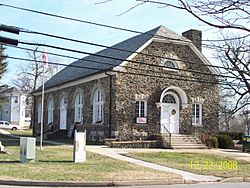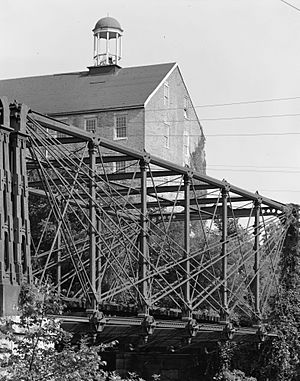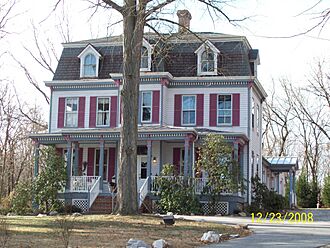Savage, Maryland facts for kids
Quick facts for kids
Savage, Maryland
|
|
|---|---|

Carroll Baldwin Hall
|
|
| Country | |
| State | |
| County | Howard |
| Area | |
| • Total | 2.74 sq mi (7.10 km2) |
| • Land | 2.74 sq mi (7.09 km2) |
| • Water | 0.01 sq mi (0.01 km2) |
| Elevation | 210 ft (60 m) |
| Population
(2020)
|
|
| • Total | 7,542 |
| • Density | 2,756.58/sq mi (1,064.29/km2) |
| Time zone | UTC−5 (EST) |
| • Summer (DST) | UTC−4 (EDT) |
| ZIP Code |
20763
|
| Area code(s) | 240, 301 |
| FIPS code | 24-70475 |
| GNIS feature ID | 591233 |
Savage is a special community in Howard County, Maryland, USA. It's not officially a city, but it's a recognized place where people live. Savage is about 18 miles south of Baltimore and 21 miles north of Washington, D.C.. It's also close to the towns of Laurel and Columbia. In 2020, about 7,542 people lived here.
Savage used to be a busy town with mills. Many of its original buildings are still standing. They are part of the Savage Mill Historic District, which means they are important historical sites.
Contents
Exploring Savage's Past
Early Days: The 1600s and 1700s
People first settled in the area of Savage around 1650. In 1685, a man named Colonel Henry Ridgley explored the land. He called it "Ridgely's Forrest." Later, in 1734, Joseph White opened a gristmill here. A gristmill grinds grain into flour.
The Rise of Mills: The 1800s
Savage became a very important place for making textiles (like cloth). Mills used the power of the Little and Middle Patuxent rivers to run their machines.
The town got its name from John Savage. He was a merchant from Philadelphia. In 1822, he and his partners started the Savage Manufacturing Company. They bought a lot of land and began making sails for clipper ships. These ships sailed out of Baltimore Harbor. They also made many other cotton products.
Cotton and Trains
In the 1800s, cotton was brought cheaply from Southern ports. It was carried by mules and oxen to the mills. Then, in 1835, the B&O Railroad line was built. A train station, Savage Station, opened nearby.
In 1887, a special train track was built to the Savage factory. This is when the famous Bollman Truss Railroad Bridge was moved to Savage. It was first built in 1852. This iron bridge is the only one of its kind left in the world! It's a very important historical landmark, just like the Savage Mill.
The Savage post office opened in 1836. It helped people send and receive mail. The mill itself grew a lot in 1880. It started using steam power. During this time, the mill made things like army uniforms and tents.
Modern Times: The 1900s and Beyond
In 1984, the Savage Mill began a big project. It was turned into a large marketplace. Today, you can find shops and businesses there. The Savage Mill Manor House, a beautiful old home near the mill, was also fixed up. It's now used for weddings and other events.
Carroll Baldwin Hall was built in the early 1920s. It was a memorial to Carroll Baldwin, a former president of the mill company. This building once held the Savage branch of the Howard County Library.
Community Changes
For many years, Savage, like many places, had different groups of people living and working separately. Over time, especially in the second half of the 1900s, the community became more integrated.
The Savage Volunteer Fire Company started in 1937. They moved to a new station in 2013. In 1972, a big storm called Hurricane Agnes caused the local rivers to flood. The road bridge was washed away. A new bridge opened a few years later in 1975. In 1988, a new elementary school, Bollman Bridge Elementary, was built in Savage.
Where is Savage?
Savage is in the southeastern part of Howard County. It's next to Columbia to the north and North Laurel to the southwest. A main road, U.S. Route 1, runs along its southeast side. The historic Savage mill village is in the southern part of the area. A big highway interchange, where Interstate 95 and Maryland Route 32 meet, is on the northern edge.
The Middle Patuxent and Little Patuxent rivers meet west of the mill village. The river drops about 70 feet in a short distance. This drop created the "falls" that powered the old mills. The Little Patuxent River then flows southeast to join the main Patuxent River.
People in Savage
| Historical population | |||
|---|---|---|---|
| Census | Pop. | %± | |
| 2020 | 7,542 | — | |
| U.S. Decennial Census | |||
Savage is home to a growing number of people. In 2020, the population was 7,542 residents.






